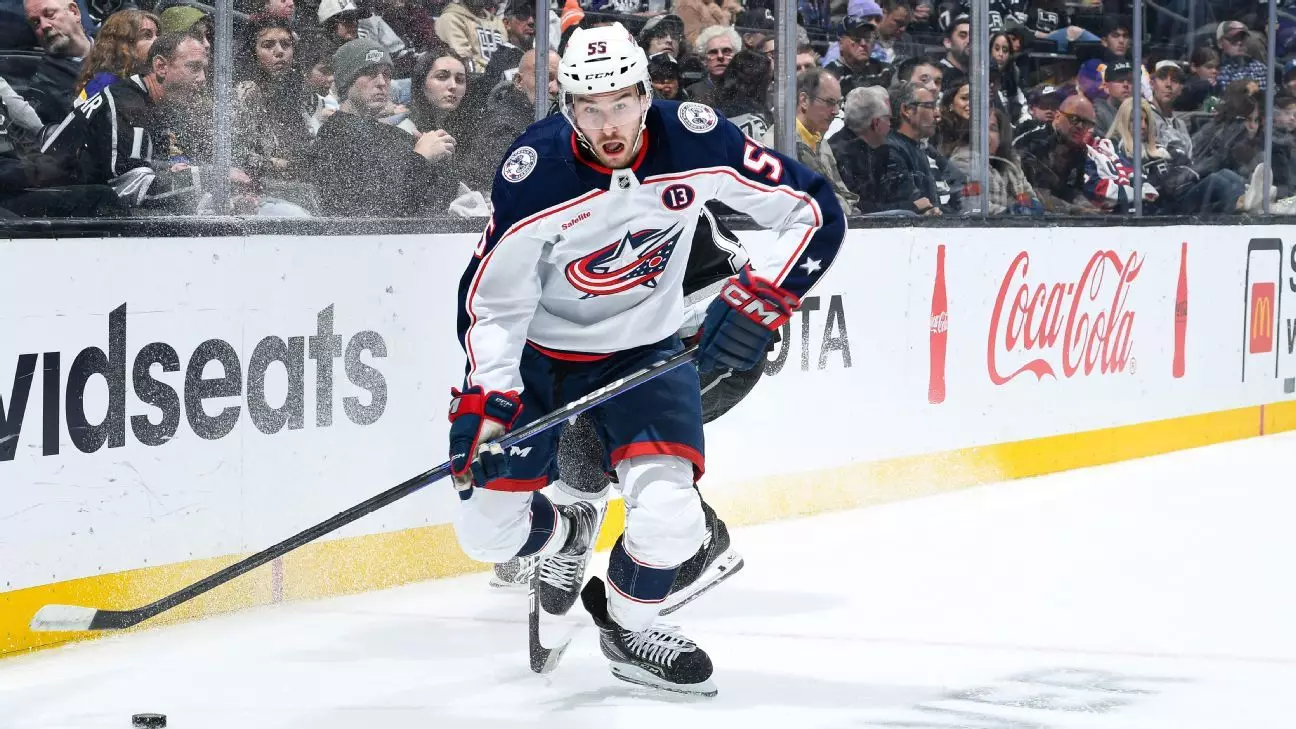In a significant move that might reshape the futures of both the Columbus Blue Jackets and Minnesota Wild, defenseman David Jiricek, the sixth overall pick in the 2022 NHL Draft, was traded. This trade showcased the ongoing evolution within each franchise as they navigate their unique trajectories and address immediate team needs. The Wild acquired Jiricek along with a fifth-round pick in 2025, while the Blue Jackets received not only Jiricek but also a package of draft picks, including a top-five protected first-round pick in 2025, along with several additional selections.
For the Minnesota Wild, this trade represents a calculated step toward fortifying their defensive corps. Last season underscored significant insights into their young defensive capabilities, prominently highlighted by Brock Faber’s emergence—who secured a second-place finish in Calder Trophy voting. Nonetheless, the aging defense behind him became a pressing concern, with key figures like Zach Bogosian and Jared Spurgeon nearing or over the age of 30. The organization recognized a necessity to rejuvenate their back line through talented, younger players and has already initiated this process. Jiricek’s arrival adds to a burgeoning defensive pipeline that includes previous draft picks such as Carson Lambos and Zeev Buium.
The Wild’s decision-making shows foresight—might they have unearthed another gem in Jiricek? His statistics in the AHL demonstrate promise, as he has tallied 60 points across 88 games. However, whether he converts that production into NHL success remains an open question. For the Wild, maintaining success in a highly competitive Western Conference relies on not only their established players but also the integration of younger talent, making Jiricek’s performance pivotal.
Conversely, the Columbus Blue Jackets’ approach post-trade indicated a strategic pivot towards rebuilding. Jiricek’s turbulent start in Columbus and subsequent demotion to the AHL revealed possible discomfort in his role. His trade might not just symbolize his unfulfilled potential but also facilitates clarity regarding the team’s current defensive strategies. With an eye on the future, GM Don Waddell capitalized on the opportunity to amass additional draft picks, expanding their arsenal to a total of 27 selections over the next three years. This abundance of picks bodes well for a franchise eager to reinforce its foundations.
Moreover, the composition of the Blue Jackets’ roster illustrates their commitment to integrating youth into their system. With five out of seven active defensemen under 27, the absence of Jiricek may not be as detrimental as it seems. The recent draft history—highlighted by selections like Corson Ceulemans and Denton Mateychuk—indicates a clear route towards a more dynamic defensive unit. The Blue Jackets’ timeline for rebuilding looks calculated and deliberate, factoring in both immediate need and future sustainability.
The trade not only benefited both teams in terms of immediate roster adjustments but also signaled a strategic management of resources on both sides. The Minnesota Wild have effectively minimized their salary cap strain, as Jiricek’s entry-level contract provides a rare financial advantage. Given that the franchise is currently navigating the constraints of the expensive buyout contracts of Zach Parise and Ryan Suter, this aspect cannot be understated.
As for Columbus, the ability to accumulate draft assets grants them flexibility moving forward. The recipe for success traditionally gravitates toward effective drafting and player development. In Waddell’s tenure with the Carolina Hurricanes, building through the draft has been a cornerstone, unveiling a consistent contender. By adopting a similar philosophy in Columbus, the franchise seeks to not just secure immediate improvements but to cultivate a perennial playoff challenger.
Ultimately, the Jiricek trade encapsulates broader narratives of transformation within NHL franchises. For the Minnesota Wild, it is an opportunity to solidify their youthful core and potentially uncover the next big breakout star, while for the Columbus Blue Jackets, it marks a step in redefining their roster for enhanced future viability. By shifting perspectives and embracing strategic management of player potential and draft capital, both organizations are positioned to wield a level of success that may illuminate the path toward becoming significant forces within the league. Time will reveal how fully each team capitalizes on this pivotal decision, but the foundations laid by this trade have created ripples that could reshape their competitive landscapes for years to come.


Leave a Reply